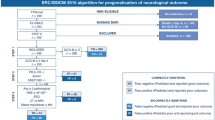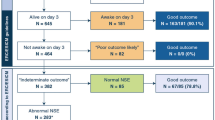Summary
Background
Patients successfully resuscitated from cardiac arrest are at high risk of increased mortality and their longterm outcome is often complicated by developing severe neurological disorders up to a persistant vegetative state. We investigated the prognostic value of some epidemiological and clinical markers and two neuroproteins, neuron-specific enolase (NSE) and S 100 protein (S 100), in 97 patients undergoing cardiopulmonary resuscitation after nontraumatic cardiac arrest between 1998 and 2002.
Results
52.6% of the patients died, 28.8% survived with moderate or without neurological disorders, and 39% with persistent vegetative state. The persistence of unconsciousness over 48 hours after CPR and a Glasgow Coma Score (GCS) of less than 6 points after 72 hours predicted a 60-fold higher risk of poor neurological outcome. A serum NSE level of more than 65 ng/ml and a serum S 100 level of more than 1.5 μg/l were found to be predictors of death and not regaining consciousness, with a high specificity (96%) and a positive predictive value of 97%. To exceed these limits, increases the risk of poor neurological outcome and death by 16.8- and 12.6-fold.
Conclusions
We recommend in addition to the day-to-day clinical examination with enquiry of the Glasgow Coma Score, the measurement of the serum levels of NSE or S 100 protein over a fiveday period as markers with a high predictive value for poor cerebral outcome. The combination of GCS and the serum levels of NSE or S 100 protein at 72 hours after CPR permit a more reliable prediction of outcome in postanoxic coma than clinical examination and serum markers alone.
Zusammenfassung
Patienten, die bei einem Herz-Kreislaufstillstand primär erfolgreich reanimiert werden, haben im weiteren Verlauf ein hohes Risiko zu versterben bzw. ein schweres neurologisches Defizit zu entwickeln, bis hin zum apallischen Syndrom. Wir untersuchten von 1998 bis 2002 bei 97 Patienten den prognostischen Vorhersagewert epidemiologischer sowie klinisch-neurologischer Parameter und der beiden Neuroproteine NSE und S 100.
Ergebnisse
52,6% der Reanimierten verstarben, 28,8% überlebten mit mäßigem bzw. ohne neurologisches Defizit. 39% der Langzeitüberlebenden entwickelten ein appallisches Syndrom. Das Fortbestehen einer komatösen Bewusstseinslage über 48 h nach CPR und ein GCS von < 6 Punkten waren mit einem 60fach höherem Risiko für eine schlechte neurologische Prognose verbunden. Das Überschreiten einer NSE-Serumkonzentration von 65 ng/ml bzw. einer S 100-Serumkonzentration von 1,5 μg/l erhöhten das Risiko für eine schlechte Prognose um das 16,8- bzw. 12,6fache.
Schlussfolgerungen
Wir empfehlen für die individuelle Prognoseermittlung komatöser Überlebender nach CPR die mindestens einmal tägliche klinischneurologische Untersuchung mit Erhebung des GCS-Punktewertes und die einmal tägliche Bestimmung der Serumkonzentration von NSE oder S 100. Die Kombination von GCS-Punktewert und den Serumkonzentrationen von NSE und S 100 erhöht den Vorhersagewert gegenüber den Einzelparametern.
Similar content being viewed by others
Author information
Authors and Affiliations
Rights and permissions
About this article
Cite this article
Pfeifer, R., Börner, A. & Figulla, H.R. Prognose nach Herz-Kreislaufstillstand. Intensivmed 41, 171–180 (2004). https://doi.org/10.1007/s00390-004-0438-z
Received:
Accepted:
Issue Date:
DOI: https://doi.org/10.1007/s00390-004-0438-z
Key words
- Cardiopulmonary resuscitation
- prognostic markers
- Glasgow Coma Score
- neuron-specific enolase
- S 100 protein




